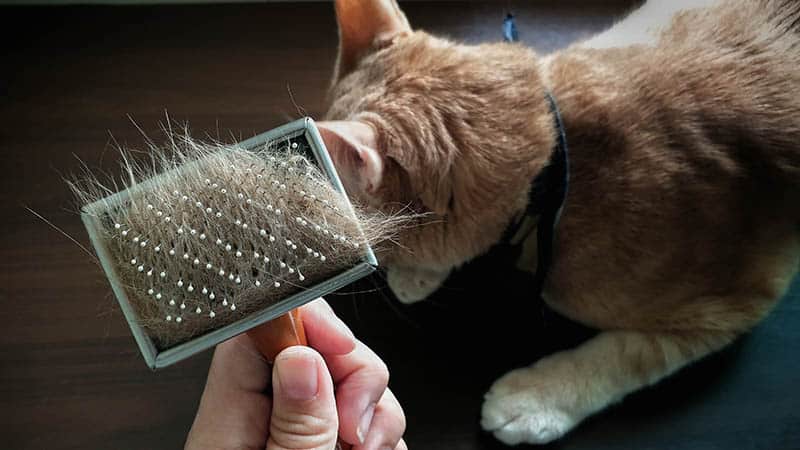Like humans, cats have their own unique personalities and one way for them to embody their individuality is through their names! Although independent at times, this doesn’t necessarily mean they can’t learn their names.
Teaching your cat their name enhances communication and strengthens the bond between you and your feline friend. In this article, we will explore how to teach a cat its name, from selecting the perfect name to a simple step-by-step training guide!

Things to Consider Before Starting
Choosing Your Cat’s Name
Before learning how to teach your cat their name, actually choosing a fitting name for them is the crucial first step. Opt for a simple, one- or two-syllable name that’s easy to say. Make sure it’s a name you and your family like, as you’ll be using it frequently. It’s best to avoid names that sound like common commands to prevent confusion. The right name sets the foundation for effective recognition and response.
To keep things fun and personal, you can find a name that fits your cat’s appearance, quirks, and behavior!
Be Sure to Stick with the Chosen Name
Consistency is key when teaching your cat their name. Once you’ve selected a name, commit to it! Changing names will confuse your pet. Stick with the chosen name, so your cat can easily associate good things with it.
Inform All Household Members and Visitors of the Cat’s Name
It’s essential that everyone in your household and any regular visitors know your cat’s name. Consistency across all interactions helps your cat recognize and respond to their name, fostering a stronger link and more effective communication.


The 12 Tips on How to Teach a Cat Their Name
1. Consistency Is Key
Consistency plays a pivotal role in successfully teaching your cat their name. Using the chosen name and avoiding nicknames or variations ensures clarity for your feline friend.
Cats thrive on routine and repetition, so hearing their name consistently reinforces the connection between the sound and a positive experience, which may entitle a reward in the form of food, toys, or attention. It’s crucial to get your cat to associate their name with a positive consequence.
2. Start in a Quiet Environment
Starting the training in a tranquil and distraction-free environment is crucial when teaching your cat their name. By beginning in a quiet space, such as a dedicated training area or a calm room, you create an ideal setting for focused learning.
This peaceful environment allows your cat to concentrate on the sound of their name and associate it with positive experiences, making the learning process smoother and more effective.

3. Say the Name Often
Frequent repetition is key when teaching your cat their name. Repeatedly saying their name throughout the day, especially when they are already looking at you or when you’re about to engage with them, helps to reinforce the association between the sound and a positive consequence.
However, if your cat is not paying attention or is looking in another direction, do not overuse the name, as this will reinforce the habit of ignoring the sound of it. Be patient and take your time, as it may take a while for your cat to respond to their name. Some will learn it but choose to ignore it1. So, remember to ensure the consequence of responding to their name is desirable for your cat.
4. Reward and Reinforce
Reward and reinforcement are essential components of teaching your cat their name. When your cat responds to their name, promptly reward them with praise, a treat, or some playtime!
This positive reinforcement strategy helps your cat associate the sound of their name with pleasurable experiences and positive consequences, making them more likely to respond in the future. The connection between their name and positive outcomes strengthens the likelihood of your cat responding with their attention when being called.
5. Focus on One Short and Prompt Response
Keeping training sessions short is crucial when teaching your cat their name. Cats have relatively short attention spans, and prolonged sessions can lead to boredom or frustration, hindering the learning process.
By adjusting your goals to one short and good response and repeating it a few times per day, you can engage your cat’s interest and focus.
- Call the name and the cat looks at you, then they get a treat.
- Call the name and the cat stands and starts walking toward you, and then they get a treat.
- Call the name and the cat comes to you, and then they get a treat.
Feel free to stay in each step for a while. We are working on building a very strong history of reinforcement with name response. The extra time spent here is well worth it. Short sessions allow for frequent, positive interactions that contribute to gradual progress and improved retention.

6. Be Patient
Patience is a virtue when teaching your cat their name. Cats are known for their independent nature, and each feline has their own pace for learning and adapting. It’s essential to understand that the process of recognizing and responding to their name can take time.
By demonstrating patience, you create a low-stress environment that fosters trust and cooperation between you and your cat, making the training process smoother and more rewarding for both of you.
7. Gradually Increase Distractions
Gradually introducing distractions is a vital part of teaching your cat their name. Once your cat responds consistently in a quiet environment, it’s time to expand the training to more challenging settings.
Slowly introduce distractions like other people, pets, or background noise, during training sessions. This method helps your cat learn to focus on their name amidst various stimuli, making their response more reliable in real-life situations.
8. Keep a Positive Attitude
Maintaining a positive attitude is paramount when teaching your cat their name. Cats may respond to their owner’s emotions, and a positive, encouraging demeanor can significantly impact the training process.
Avoid frustration or impatience and instead approach each training session with enthusiasm and optimism. When your cat sees that their efforts to respond to their name are met with your approval and delight, they’ll be more motivated to learn and participate.

9. Practice Regularly
Consistent practice is the cornerstone of successfully teaching your cat their name. Regular repetition and reinforcement are key to strengthening your cat’s recognition and response to their name. Incorporate their name into daily interactions, such as playtime and feeding, and consistently hold short training sessions.
These practice sessions should be a part of your daily routine, creating opportunities for your cat to continually improve their association and responsiveness.
10. Be Mindful of Body Language
Being mindful of your cat’s body language is a crucial aspect of teaching them their name. Cats communicate through their posture, expressions, and movements, and paying attention to these cues during training can provide valuable insights. If your cat exhibits signs of discomfort, stress, or disinterest, it’s essential to adjust your approach and take a break.
This attentiveness to your cat’s body language not only enhances the training experience but also strengthens the trust between you and your feline friend.
11. Don’t Forget to Celebrate!
Celebrating your cat’s successes in learning their name is a vital component of the training process! When your cat consistently responds to their name, it’s an achievement worth acknowledging. Celebrate their progress with extra praise, affection, and, of course, their favorite treats or toys.
This celebration not only reinforces their positive association with their name but also deepens the bond between you and your cat. The joy you express during these moments of recognition and success makes the training experience enjoyable and affirms the trust and connection you share with your cat!

12. Always Watch Your Tone
There will be times when your cat’s mischievousness or their simple desire to ignore you will trigger your frustration. When this happens, you should avoid calling their names in an irritated, loud, or unfriendly tone. Remember, every interaction counts and is shaping your cat’s behavior.
When you call your cat’s name, the goal is for them to have a positive response to it. If your cat starts to have a negative association with the chosen word for their name, your chances of them responding in the future will be affected. Be clever about it and go out for a walk or take a deep breath, but mind your tone and think about the long-term goals.

Final Thoughts
Teaching your cat their name is a process that requires patience and consistency. By following the step-by-step guide outlined in this article and staying positive throughout the training, you’ll be well on your way to a stronger connection with your feline companion.
Remember, every cat is unique, so adapt the training to their individual pace and preferences and enjoy the journey of strengthening your bond with your furry friend!
Featured Image Credit: Svetlana Rey, Shutterstock



















